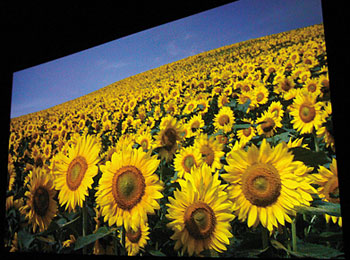The Future of 'Super HD' Scanning Formats

We have taken a look at HDTV and other high-resolution scanning formats. Now let's look at a "Super HD" scanning format, and some others that are being considered by SMPTE for standardization. These won't be broadcast or put on cable any time soon, but those in front of SMPTE are intended to be used in digital cinema capture.
In the world of HDTV scanning formats, the highest spatial resolution is delivered by 1920x1080, which is commonly broadcast as 1080i/29.97 frames per second, and is commonly used for film-to-video transfer and HD camera capture as 1080p/24 fps. For film and digital cinema applications, we get into so-called 2K and 4K resolutions, which are currently file-based.
Japanese broadcaster NHK, the organization that, along with several Japanese broadcast equipment manufacturers, launched the HDTV juggernaut that we first saw in the United States back in 1980 or so with Hi-Vision, has been working on a format called "Super Hi-Vision."
INTRODUCING HI-VISION
Hi-Vision itself hit the scene as a high-resolution extension of the tried-and-true interlaced standard-definition scanning format. It appeared during the analog television era, and its scanning characteristics were 1125 total lines per frame, 1035 active lines per frame, 2:1 interlace, 30.00 frames per second (60.00 fields per second), with an aspect ratio of 15:9.

Japan broadcaster NHK has been dazzling broadcast trade show audiences with its "Super-Hi Vision" demonstrations for the past several years. Its aspect ratio was changed to 16:9 to conform to the international standard HDTV aspect ratio, and it furnished the basis for today's 1080i/29.97 digital HD scanning format, the characteristics of which are 1920 horizontal pixels per line, 1125 total lines per frame, 1080 active lines per frame, 29.97 frames or 59.94 fields per second. The design viewing distance for this scanning format is 3.0 picture heights, which establishes a viewing angle of 31 degrees.
For reference, 4K digital cinema currently uses 4096 horizontal pixels by 2160 vertical lines, for an ideal viewing distance of about 1.5 picture heights, and a commensurate viewing angle of about 58 degrees.
AN IMMERSIVE EXPERIENCE
Super Hi-Vision has 7680 horizontal pixels by 4320 lines, with an intended viewing distance of 0.75 picture height and a viewing angle of 96 degrees. This could fairly be called an immersive experience, and it definitely requires the viewer to move his or her head and eyes around to see the entire screen. It is almost an 8k system, with four times 1920x1080's horizontal pixel count, and four times its line count. We have, it appears, at long last, entirely abandoned interlaced scanning formats as it is progressively scanned, although this is a Japanese-created format.
It is the expressed hope of the Japanese Ministry of Internal Affairs and Communications to have Super Hi-Vision internationally standardized, and to begin broadcasting it in 2015. Demonstrations have shown Super Hi-Vision video compressed from 24 Gbps to 180-600 Mbps, so this format will definitely require broadcasting by satellite, not terrestrially.
Meanwhile, two production image scanning formats for D-cinema, 2048x1080 and 4096x2160, have been submitted to SMPTE for standardization.
One variant of the 2K sample matrix is 2048x1080, which has heretofore been file-based only. We see that it has the same number of scan lines as 1920x1080, and a slightly higher horizontal resolution, at 2048 pixels rather than 1920. Its aspect ratio is consequently slightly wider than 1920x1080, at about 1.90/1. It also has 1125 total lines per frame, the same as 1920x1080. It is accompanied by a list of frame rates that includes every television frame rate now used in the world and then some: 60, 59.94, 50, 48, 47.95, 30, 29.97, 25, 24, 23.98 fps. The 48 and 47.95 fps frame rates are, of course, for theatrical display, 24 fps film being projected today using double-shuttering that generates a 48 fps large-area light flash rate.
FAMILIAR TERRITORY
The interface sampling frequency for this format is the familiar 74.25 or 74.25/1.001 MHz for frame rates up to and including 30 fps. It is doubled to 148.5 or 148.5/1.001 MHz for the higher frame rates. To repeat, there is no interlace-scanned version of this format.
The 4096x2160 format is simply a doubled-up version of 2048x1080, with twice the horizontal pixels and twice the vertical lines of the 2048x1080 version. It therefore also has an aspect ratio of about 1.90:1. It shares all the frame rates listed for 2048x1080, and it too is only progressively scanned.
These two proposed D-cinema scanning formats are not entirely unfamiliar, in that they have spatial resolution characteristics familiar to the 2K and 4K file-based formats that are routinely used in D-cinema capture, high-resolution film-to-video transfer, and digital intermediate processes. They are however, proposed in the form of video scanning formats, which are not familiar to us. They will require dual-link, multiple-link, or as yet undeveloped, extremely high-speed single interfaces.
As an example, the 4096x2160 format would require dual 3 Gbps links or a single-link interface at 6 Gbps, an interface that is somewhat hard to imagine today. It is relatively straightforward for SMPTE to standardize these formats on paper, as they are technically feasible and sound. However, getting them from place to place is another matter. We are indeed living in exciting technological times.
Randy Hoffner, a veteran of the big three TV networks, is a senior consulting engineer with AZCAR. He can be reached through TV Technology.
Get the TV Tech Newsletter
The professional video industry's #1 source for news, trends and product and tech information. Sign up below.

